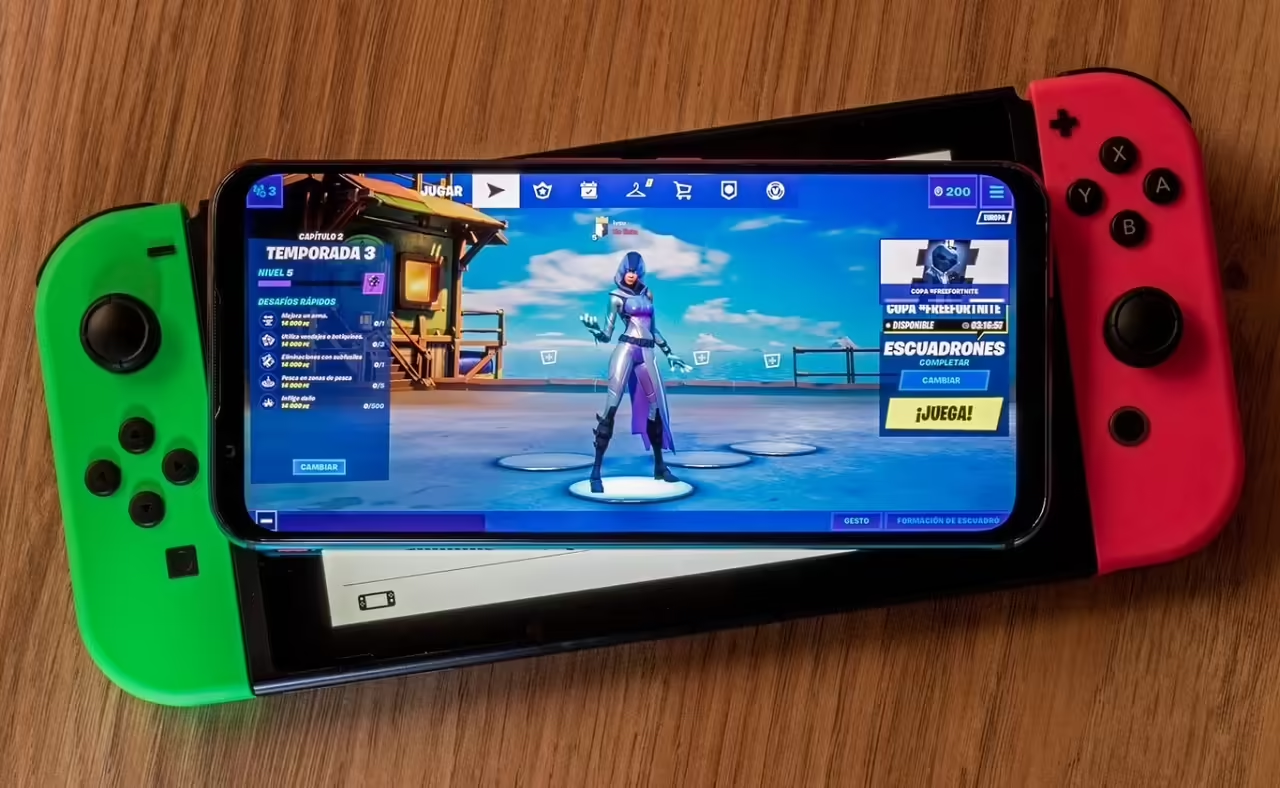Technological Evolution: The Quantum Leaps in Mobile Phone Power
In recent years, we’ve witnessed an impressive transformation in mobile phone technology. What was once a simple device for making calls and sending text messages is now a powerful machine capable of running complex applications, advanced graphics, and games that rival handheld consoles. This article explores how technological evolution has enabled mobile phones to achieve a level of performance that was, not too long ago, exclusive to gaming consoles.
The Evolutionary Leap: From Communication to Advanced Entertainment
The advancement of mobile phones has been accelerated by the need to integrate more functions into a compact device. What began with the incorporation of cameras, internet browsers, and music players quickly gave way to more powerful processors, high-resolution displays, and impressive graphical capabilities. Today, mobile phones are multifunctional tools that support entertainment activities once only seen on handheld consoles.
Next-Generation Processors and GPUs: The Heart of Performance
One of the most crucial aspects of mobile phone evolution has been the development of increasingly powerful processors and graphics processing units (GPUs). Modern chips, such as Apple’s A17 Pro and Qualcomm’s Snapdragon 8 Gen 3, have achieved performance levels that directly compete with handheld consoles. These processors are not only capable of handling multitasking effortlessly but also provide the power necessary to run games with high-quality graphics and advanced physics.
High-Resolution Displays: A Window into the Digital World
Advances in display quality have been another key factor. OLED and AMOLED screens, with their vibrant colors and deep blacks, along with refresh rates of up to 120Hz or more, provide a visual experience that rivals that of handheld consoles. Additionally, the growing adoption of HDR (High Dynamic Range) displays allows for a wider color gamut and better contrast, enriching the gaming experience on mobile devices.
Software Optimization: The Role of the Operating System
The evolution of software is as important as that of hardware. Mobile operating systems like Android and iOS have been optimized to make the most of the available hardware. Advanced graphics APIs like Vulkan and Metal allow developers to create games with graphics and performance comparable to those of consoles. Furthermore, frequent updates to operating systems ensure that the newest devices are always prepared for the latest innovations in games and applications.
The Role of Connectivity: 5G and Cloud Gaming
The arrival of 5G connectivity has been a game-changer in the world of mobile phones. With ultra-low latency and download speeds, 5G enables online gaming experiences that were previously only possible on consoles connected by cable. Additionally, cloud gaming has opened up new possibilities, allowing players to access console titles on their phones without the need for expensive hardware. Services like Xbox Cloud Gaming and Nvidia GeForce Now are driving this trend, making mobile phones an increasingly viable option for hardcore gamers.
Battery and Cooling: The Challenges of Mobile Performance
As mobile phones approach the performance of handheld consoles, they face unique challenges such as heat management and battery life. Advanced cooling solutions, such as vapor chambers and heat-conducting materials, have enabled phones to maintain stable performance during prolonged gaming sessions. However, battery life remains a challenge, although significant advances are being made in battery technology and hardware energy efficiency.
The Future: Mobile Phones as a Replacement for Handheld Consoles?
The technological progress in the realm of mobile phones suggests that it’s not far-fetched to envision a future where these devices could completely replace handheld consoles. While there is still work to be done, particularly in areas like battery life and ergonomics for long gaming sessions, mobile phones have already demonstrated that they can deliver a high-quality gaming experience.
With continued innovation in processors, displays, connectivity, and software, it is likely that mobile phones will not only match but eventually surpass handheld consoles in terms of performance and versatility. The question is no longer whether mobile phones can match the power of handheld consoles, but when they will do so.
High-Performance Components: What’s Still Needed?
In the race to achieve handheld console-level performance on mobile phones, key components like processors and graphics processing units (GPUs) play a fundamental role. These elements are the heart of a mobile device’s performance and determine its ability to run complex applications and games smoothly and with high graphical quality. Below, we explore what’s still needed in these components for mobile phones to compete with handheld consoles.
Processors: The Brain of Performance
The processor, also known as the central processing unit (CPU), is the brain of any mobile device. Modern mobile phones are equipped with multi-core processors that allow for the execution of multiple tasks simultaneously without compromising performance. However, to compete with handheld consoles, mobile processors must continue to evolve in several key areas:
More Cores and Multithreaded Efficiency: As mobile games become more complex, it’s essential for mobile processors to offer more cores that can efficiently handle multiple execution threads. This allows the device to manage intensive graphics and complex tasks without slowdowns.
Higher Clock Speeds: Although current mobile processors are impressively fast, there is still room for improvement in terms of clock speed, especially compared to handheld consoles. Higher clock speeds allow games to run more smoothly and reduce load times.
Advanced Architecture and Energy Efficiency: Mobile processors need advanced architecture that not only delivers high performance but also remains energy-efficient. This is crucial in mobile devices, where battery life is a decisive factor. Next-generation architectures, such as ARM Cortex-X, are designed to maximize performance while minimizing energy consumption.
GPU: Graphics Power in the Palm of Your Hand
The GPU is responsible for rendering graphics and is essential for games requiring high visual quality. In recent years, mobile GPUs have seen significant improvements, but there is still work to be done to match the level of handheld consoles.
More CUDA Cores and Shading Units: For mobiles to compete with consoles, their GPUs need more CUDA cores (for Nvidia) or shading units (for other architectures). This will allow phones to handle more complex graphics, advanced visual effects, and higher resolutions without compromising frame rates.
Ray Tracing Support: Ray tracing is a rendering technique that simulates how light interacts with objects in an environment, creating more realistic shadows, reflections, and lighting effects. Although this technology is already present in some consoles and desktop GPUs, full integration into mobile devices is still in progress. For mobiles to achieve graphics performance comparable to consoles, full ray tracing support is necessary.
Energy Efficiency Optimization: Just like processors, mobile GPUs need to be highly efficient in energy consumption. Chip manufacturers are working on solutions that balance graphical power with energy efficiency, using technologies like Dynamic Voltage and Frequency Scaling (DVFS) to adjust GPU performance in real-time based on game demands.
RAM: Speed and Capacity
RAM is another crucial component that directly affects gaming performance on mobile devices. To compete with handheld consoles, phones need fast and ample RAM to handle large volumes of data simultaneously.
LPDDR5X Memory: The latest generation of mobile RAM, LPDDR5X, offers higher data transfer speeds and lower latency compared to previous versions. This allows games to load faster and for the system to handle more detailed textures and 3D models without delays.
Increased Capacity: While many high-end phones already have 12 GB or more of RAM, the trend is towards even higher capacity to support next-generation games and applications that require more memory. This is particularly important for games that load large maps and complex textures in real-time.
UFS Storage: Speed in Game Loading
Storage is another factor influencing the overall performance of phones. Modern games, especially those with advanced graphics, require fast storage to load game data quickly and reduce wait times.
UFS 4.0: The latest version of Universal Flash Storage (UFS), UFS 4.0, offers significantly higher read and write speeds compared to previous versions. This translates to faster load times and a smoother gaming experience.
Storage Capacity: With mobile games reaching sizes of several gigabytes, it is essential for phones to offer large storage capacities, preferably with options for expansion via microSD cards or cloud storage.
Cooling Technology: Keeping Performance Stable
One of the biggest challenges in mobile devices is heat management. As phones become more powerful, they generate more heat, which can affect performance if not managed properly.
Vapor Chambers and Heat Dissipation Materials: Vapor chambers and advanced heat dissipation materials, such as graphene, are used to keep temperatures under control during intense gaming sessions. This ensures the device maintains stable performance without overheating.
Active Cooling Systems: Some gaming phones are already integrating active cooling systems, such as small fans, to enhance heat dissipation. While this increases the device’s thickness, it is an effective solution for maintaining performance.
Optimization and Performance: The Role of Software in Performance
In the race to achieve console-level performance on mobile phones, software optimization and operating system efficiency are as crucial as the hardware itself. Although high-end processors, GPUs, and other components are fundamental, without optimized software to fully utilize these capabilities, all that hardware potential would be wasted. In this article, we explore how software optimization and operating systems influence the maximization of hardware performance in mobile devices.
Operating Systems: The Foundation of Performance
Mobile operating systems, such as Android and iOS, are the backbone on which the entire ecosystem of a phone is built. These systems are designed to manage how hardware and software interact, ensuring that device resources are used efficiently. Without an optimized operating system, even the most advanced hardware could experience performance issues such as overheating, excessive battery consumption, or latency.
Resource Management: An efficient operating system intelligently allocates device resources, such as the CPU, GPU, and RAM, according to the needs of running applications. This is essential for maintaining smooth performance and avoiding unnecessary resource depletion.
Process Prioritization: Modern operating systems prioritize processes based on their importance. For example, a game requiring high processing power may receive more CPU and GPU resources, while background applications are limited to conserve energy and resources.
Constant Updates: Operating system updates are crucial for maintaining compatibility with the latest hardware and for fixing bugs that could affect performance. These updates often include improvements in power management and resource optimization, contributing to overall better performance.








